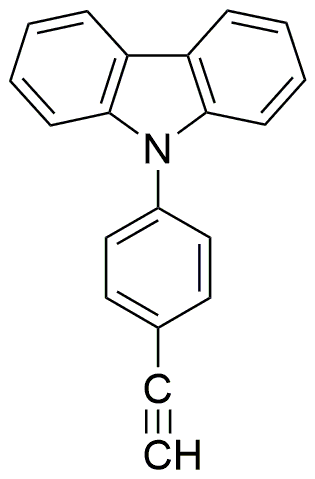9-(4-Ethynylphenyl)carbazole is widely utilized in research focused on:
- Organic Electronics: This compound is a key material in the development of organic light-emitting diodes (OLEDs), which are used in displays and lighting. Its unique properties enhance efficiency and color purity.
- Photovoltaics: It serves as a promising component in organic solar cells, improving energy conversion efficiency. This application is crucial for advancing renewable energy technologies.
- Fluorescent Sensors: The compound is used in creating sensors for detecting environmental pollutants. Its fluorescence properties allow for sensitive and selective detection, making it valuable in environmental monitoring.
- Polymer Science: It acts as a building block for synthesizing new polymers with tailored electronic properties, which can be applied in various fields, including coatings and adhesives.
- Research in Photonics: This chemical is explored in the field of photonics for its ability to manipulate light, which can lead to advancements in optical devices and communication technologies.
Informations générales
Propriétés
Sécurité et réglementation
Applications
9-(4-Ethynylphenyl)carbazole is widely utilized in research focused on:
- Organic Electronics: This compound is a key material in the development of organic light-emitting diodes (OLEDs), which are used in displays and lighting. Its unique properties enhance efficiency and color purity.
- Photovoltaics: It serves as a promising component in organic solar cells, improving energy conversion efficiency. This application is crucial for advancing renewable energy technologies.
- Fluorescent Sensors: The compound is used in creating sensors for detecting environmental pollutants. Its fluorescence properties allow for sensitive and selective detection, making it valuable in environmental monitoring.
- Polymer Science: It acts as a building block for synthesizing new polymers with tailored electronic properties, which can be applied in various fields, including coatings and adhesives.
- Research in Photonics: This chemical is explored in the field of photonics for its ability to manipulate light, which can lead to advancements in optical devices and communication technologies.
Documents
Fiches de données de sécurité (FDS)
La FDS fournit des informations de sécurité complètes sur la manipulation, le stockage et l’élimination du produit.
Spécifications du produit (PS)
Le PS fournit une description complète des propriétés du produit, notamment sa composition chimique, son état physique, sa pureté et les exigences de stockage. Il détaille également les plages de qualité acceptables et les applications prévues du produit.
Certificats d'analyse (COA)
Recherchez des certificats d'analyse (COA) en saisissant le numéro de lot du produit. Les numéros de lot et de lot se trouvent sur l'étiquette d'un produit, après les mots « Lot » ou « Lot de fabrication ».
Numéro de catalogue
Numéro de lot/série
Certificats d'origine (COO)
Ce certificat d'exploitation confirme le pays dans lequel le produit a été fabriqué, et détaille également les matériaux et composants utilisés et s'il est issu de sources naturelles, synthétiques ou autres sources spécifiques. Ce certificat peut être requis pour les douanes, le commerce et la conformité réglementaire.
Numéro de catalogue
Numéro de lot/série
Fiches de données de sécurité (FDS)
La FDS fournit des informations de sécurité complètes sur la manipulation, le stockage et l’élimination du produit.
DownloadSpécifications du produit (PS)
Le PS fournit une description complète des propriétés du produit, notamment sa composition chimique, son état physique, sa pureté et les exigences de stockage. Il détaille également les plages de qualité acceptables et les applications prévues du produit.
DownloadCertificats d'analyse (COA)
Recherchez des certificats d'analyse (COA) en saisissant le numéro de lot du produit. Les numéros de lot et de lot se trouvent sur l'étiquette d'un produit, après les mots « Lot » ou « Lot de fabrication ».
Numéro de catalogue
Numéro de lot/série
Certificats d'origine (COO)
Ce certificat d'exploitation confirme le pays dans lequel le produit a été fabriqué, et détaille également les matériaux et composants utilisés et s'il est issu de sources naturelles, synthétiques ou autres sources spécifiques. Ce certificat peut être requis pour les douanes, le commerce et la conformité réglementaire.


